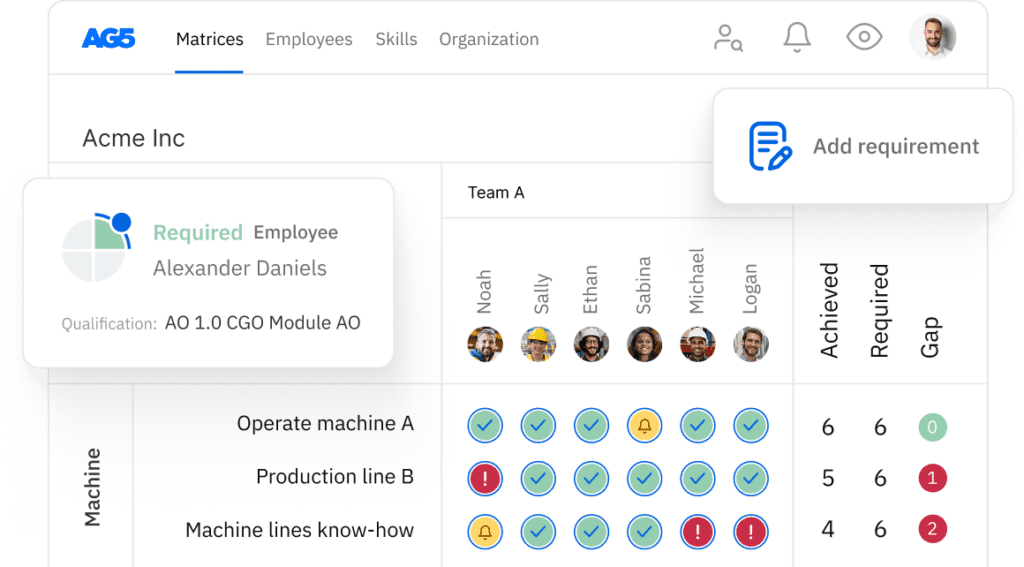70+ work-related competences at a glance
In this article, we discuss 70 work-related competences at a glance. It provides an overview of various competencies essential for professional success across diverse industries and roles.

Are you managing your company’s competences or working on your own? Then this list of competences might just come in handy! This article takes a look at the most common work-related competences.
So, what are ‘competences’ exactly?Copied
Before we take a closer look at a few examples, it’s worth explaining exactly what we mean by a ‘competence’. Because there’s often confusion about this term. You can best define the term ‘competence’ as a combination of knowledge, skills, attitudes, and other personal traits discernible in someone’s workplace behavior and required to achieve certain objectives. As such, ‘competence’ has a broader meaning than ‘skill’.
Read our article, ‘What are competences? Explanations & examples!’, for more information.
70+ competences at a glance!Copied
Below, you’ll find our list of most common work-related competences. And, of course, a brief explanation …
- accuracy – the ability to carry out work precisely within pre-determined conditions.
- active listening – the ability to remain open to new information and hear exactly what someone is saying, picking up on important signals and without interrupting.
- adaptability – the ability to maintain focus and keep moving forward, even in the event of changing circumstances, tasks, and responsibilities.
- analytical thinking – the ability to gather, analyze, and break down information in order to comprehend a complex situation, solve a problem, or gain deeper insights.
- anticipativeness – the ability to look ahead and to plan work accordingly.
- approachability – the ability to introduce oneself to other people and to get to know them.
- assertiveness – the ability to stand up for oneself without ignoring or losing sight of other people’s feelings.
- broad-mindedness – the ability to remain open to other people’s ideas and beliefs.
- coaching – the ability to help others work more effectively by providing encouragement, advice, and guidance.
- collaboration – the ability to join forces with others to achieve a common goal.
- collegiality – the ability to take account of co-workers’ needs and requirements, not just one’s own.
- commercial acumen – the ability to spot business opportunities and act accordingly, with the aim of boosting an organization’s turnover.
- communication – the ability to express oneself effectively, both verbally and in writing, in order to convey ideas clearly and concisely and to present these to others.
- consultability – the ability to ask for advice when needed or when doing so would result in a better outcome.
- creativity – the ability to make something that previously didn’t exist.
- critical thinking – the ability to avoid assumptions and probe deeper in order to get to the essence of a problem or challenge.
- daring – the ability to take risks.
- decisiveness – the ability to make decisions effortlessly and quickly.
- delegation – the ability to entrust a role and/or responsibility to others.
- diplomacy – the ability to acknowledge other people’s interests and to act accordingly so as not to disrupt or worsen mutual relations.
- directness – the ability to get to the point and address others about their conduct without being afraid to hurt their feelings.
- discipline – the ability to adhere to a set of rules or guidelines.
- drive – the ability to apply motivation and enthusiasm to carrying out a certain task.
- empathy – the ability to view and feel things from someone else’s perspective.
- encouragement – the ability to get others to take action in a positive fashion.
- energy – the ability to remain enthusiastic, alert, and full of spirit.
- engagement – the ability to connect and feel involved with your workplace, co-workers, and the work at hand, thereby motivating others around you.
- enterprise – the ability to act on personal initiative, without waiting for instructions from someone else.
- entrepreneurship – the ability to spot opportunities and to act on these accordingly for the good of the organization.
- flexibility – the ability to change course if the situation or circumstances demand.
- focus on customers/service – the ability to grasp a customer’s needs and requirements.
- focus on results – the ability to work effectively and efficiently to achieve pre-determined results.
- focus on solutions – the ability to seek and find solutions to problems and challenges.
- helpfulness – the ability to offer someone one’s time and resources to achieve their goal.
- ideation – the ability to come up with unique ideas and new solutions that are often out-of-the-box.
- independence – the ability to work autonomously without the need for guidance or instructions.
- individual leadership – the ability to guide an individual co-worker by focusing on results and behavior.
- influence – the ability to steer others toward a goal or making a change, and to transform any resistance into a positive force.
- information literacy – the ability to evaluate sources of information for reliability and usability.
- innovation – the ability to extrapolate new ideas and opportunities from existing methods or resources.
- inspiration/motivation – the ability to make others enthusiastic and create drive.
- integrity – the ability to treat others with respect and handle information confidentially.
- judgment – the ability to evaluate a situation, person, or process.
- leadership – the ability to motivate others to achieve common goals within a pre-determined set of conditions.
- learning – the ability to absorb, analyze, and process new ideas and apply them in practice.
- loyalty – the ability to conform with the interests of the group or organization as a whole.
- management – the ability to steer and direct an organization or department toward achievable goals and targets.
- monitoring – the ability to keep an eye on how things are progressing and change course accordingly when needed.
- negotiation – the ability to reach a mutually acceptable outcome despite differing interests and points of view.
- networking – the ability to establish and maintain business relations, coalitions, and partnerships inside and outside the organization.
- orderliness – the ability to keep things neat and tidy and set clear goals.
- organization – the ability to deploy the right people and resources to achieve a goal effectively and efficiently.
- perceptiveness – the ability to pick up on signals from people, the organization, the sector or society at large and respond accordingly.
- performance under pressure – the ability to work effectively and efficiently even when against the clock or under physical/emotional duress.
- perseverance – the ability to keep moving forward and achieve a goal despite problems and/or setbacks.
- persuasiveness – the ability to convince others of your point of view.
- planning – the ability to allocate time, resources, and labor to achieve a certain goal effectively and efficiently.
- presentation – the ability to convey ideas to a group of people either verbally or by means of audiovisual materials.
- reliability – the ability to keep promises, honor agreements, and own up to any mistakes.
- responsibility – the ability to take assigned tasks seriously and to see that task through to the end.
- risk awareness – the ability to identify potential hazards, bottlenecks, or pitfalls and to act accordingly.
- self-control – the ability to keep one’s emotions in check.
- self-knowledge – the ability to identify personal weaknesses, beliefs, qualities, ambitions, and interests.
- self-management – the ability to motivate, grow, and get down to work without the need for guidance or instruction from others.
- sensitivity – the ability to pick up on and act accordingly in response to other people’s feelings, emotions, behavior patterns, and attitudes.
- sociability – the ability to have and show genuine interest in other people and to help them without personal gain.
- stress resistance – the ability to perform effectively even when under time pressure or when faced by setbacks or pushback.
- supportiveness – the ability to help others by giving personal advice, based on knowledge and experience.
- uniqueness – the ability to do something in a personal and original fashion.
- uniting leadership – the ability to guide a group of people and create and nurture a mutual bond and long-lasting partnership.
- verbal communication – the ability to create mutual understanding when speaking.
- vision – the ability to form an impression of the future based on the current situation and trends.
- written communication – the ability to create mutual understanding using the written word.

A tip for companies – make competences visual!Copied
Are you encouraging competence development within your company? If so, skills matrices are one of the best ways to make this process more tangible and visual. Skills matrices provide a snapshot of all your staff’s or teams’ skills, competences, and qualifications in a schematic layout.
Using skills matrices has numerous benefits …
- see at a glance which competences are available, scarce, or missing
- find replacements and extra personnel more quickly and easily
- simplify audits by having every piece of relevant documentation at your fingertips
Using special-purpose skills management software, you can accurately map, view, and update information about your staff’s competences in real time.
Schedule a free demo to find out how skills management software would benefit your organization!

